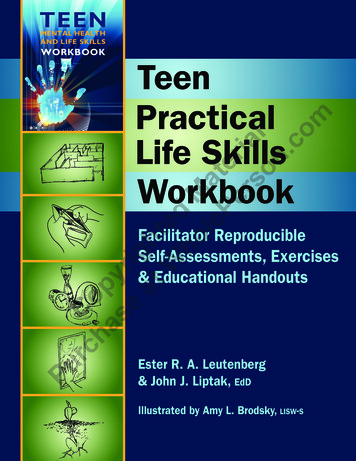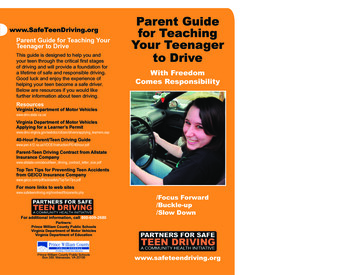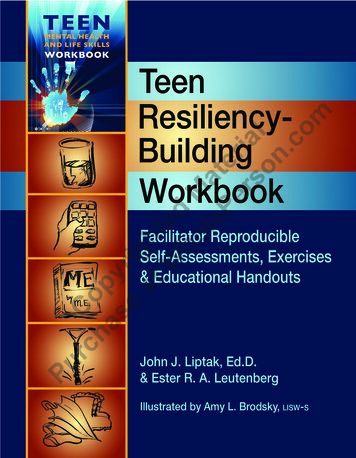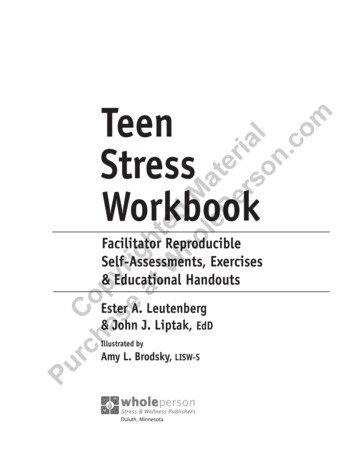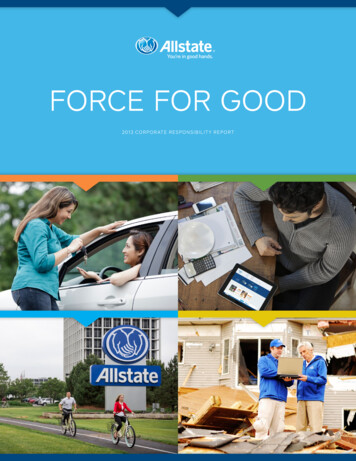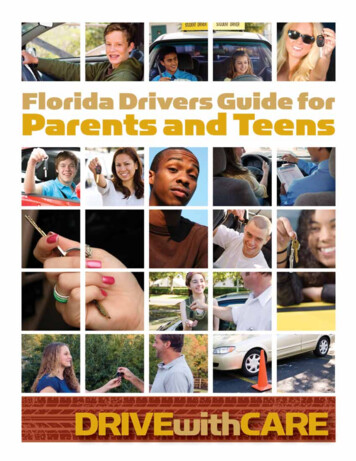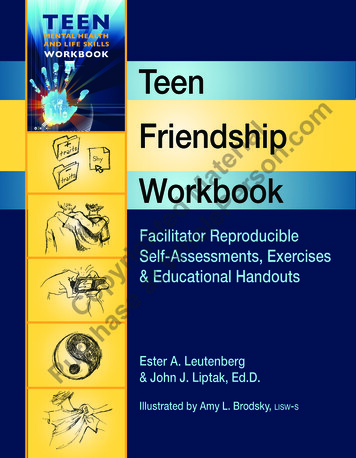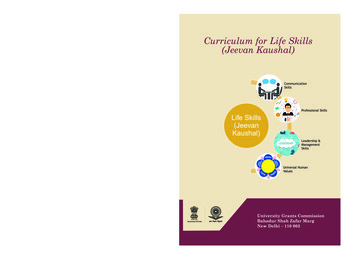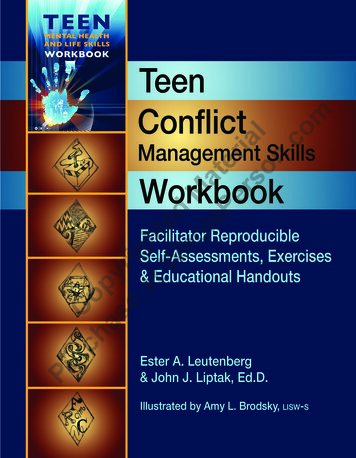
Transcription
TEENMENTAL HEALTHAND LIFE SKILLSWORKBOOKCch oas pye rigat hW tedho Mle atPe errs ialon.comTeenTeenConflictConflictManagement SkillsManagement s,Exercises Exercises& EducationalHandoutsHandouts& EducationalEster A. Leutenberg& John J. Liptak, EdDPurIllustrated byAmy L. Brodsky, LISW-SEster A. Leutenberg& John J. Liptak, Ed.D.Illustrated by Amy L. Brodsky, lisw-sDuluth, Minnesota
Cch oas pye rigat hW tedho Mle atPe errs ialon.comWhole Person101 W. 2nd St., Suite 203Duluth, MN son.comTeen Conflict Management Skills WorkbookFacilitator Reproducible Self-Assessments,Exercises & Educational HandoutsCopyright 2011 by Ester A. Leutenberg and John J. Liptak.All rights reserved. Except for short excerpts for review purposesand materials in the assessment, journaling activities, andeducational handouts sections, no part of this book may bereproduced or transmitted in any form by any means, electronicor mechanical without permission in writing from the publisher.Self-assessments, exercises, and educational handouts are meantto be photocopied.All efforts have been made to ensure accuracy of the informationcontained in this book as of the date published. The author(s)and the publisher expressly disclaim responsibility for anyadverse effects arising from the use or application of theinformation contained herein.Printed in the United States of AmericaPur10 9 8 7 6 5 4 3 2 1Editorial Director: Carlene SippolaArt Director: Joy Morgan DeyLibrary of Congress Control Number: 2011938512ISBN: 978-1-57025-259-4
Using This Book(For the professional)Conflict is a basic fact of life. As children, teens and adults we all experience conflict in ourlives. Because conflicts are disagreements resulting from people or groups having differencesin attitudes, beliefs, values or needs, conflict is inevitable. People experience differences in anytype of relationship. That conflict exists is not a bad situation, as long as the conflict is managedeffectively by resolving them in a calm, respectful way that will lead to growth and maturity.Cch oas pye rigat hW tedho Mle atPe errs ialon.comFacts for teens to know about conflict: Conflict begins when someone intrudes in another person’s comfort zoneComfort zones are defined by diverse set of beliefsWhen beliefs are challenged, conflict arisesAnger is a part of most conflict, either as a primary emotion or a secondary emotionConflict is a good thing if handled wellRelationships often flourish after a successfully-handled conflictConflict resolution habits can be learnedAny conflict has the potential to be incredibly destructive to a relationshipManaged in the wrong way, conflict can lead to extreme actions and reactionsbetween people, and conflict can quickly spiral out of control.This Teen Conflict Model is based on each participant’s point of view in a conflict. The followingformat will help participants resolve their issues when conflicts arise:ConflictManagementPurAlternativesto rControl(Continued on the next page)
Using This Book (For the professional, continued)Cch oas pye rigat hW tedho Mle atPe errs ialon.comThe Teen Conflict Management Skills Workbook contains five separate sections that correlatewith the Teen Conflict Model which will help teens learn more about themselves and the skillsthey possess, and learn ways to manage conflicts that occur in their lives. Participants willlearn new skills and the importance of preventing, managing and resolving conflicts. Conflict Triggers Scale helps teens identify the situations that trigger conflict intheir lives. Conflict Management Style Scale helps teens identify their preferred style formanaging conflict. Anger Control Scale helps teens explore how well they are able to control theiranger when they find themselves in conflict with another person. Exchange-of-Information Scale helps teens examine the communication skills theypossess for preventing conflicts and dealing with conflict situations. Alternatives to Conflict Scale helps teens identify alternative options to anger andviolence when in conflict.Use Codes for ConfidentialityConfidentiality is a term for any action that preserves the privacy of people. Because teenscompleting the activities in this workbook might be asked to answer assessment items and tojournal about and explore their relationships, you will need to discuss confidentiality beforeyou begin using the materials in this workbook. Maintaining confidentiality is important asit shows respect for others and allows participants to explore their feelings without hurtinganyone’s feelings or fearing gossip, harm or retribution.PurIn order to maintain confidentiality, explain to the participants that they need to assign aname code for each person or each group of people they write about as they completethe various activities in the workbook. For example, a friend named Joey who enjoys goingto hockey games might be titled JLHG (Joey Loves Hockey Games) for a particular exercise. Inorder to protect their friends’ identities, they should not use people’s or groups’ actual namesor initials, just codes.
Layout of the BookThe Teen Conflict Management Skills Workbook is designed to be used either independently or aspart of an integrated curriculum. You may administer one of the assessments and the journalingexercises to an individual or a group with whom you are working, or you may administer anumber of the assessments over one or more days.Reproducible Pages in the First Five Sections:Cch oas pye rigat hW tedho Mle atPe errs ialon.comq Assessment Instruments – Self-assessment inventories with scoring directions andinterpretation materials. Group facilitators can choose one or more of the activitiesrelevant to their participants.q Activity Handouts – Practical questions and activities that prompt self-reflection andpromote self-understanding. These questions and activities foster introspection andpromote pro-social behaviors.q Role-Plays – Suggestions for participants to practice newly learned techniques.q Quotations – Quotations in each section provide insight and promote reflection.Participants will be asked to select one or more of the quotations and journal about whatthe quotations mean to them.q Reflective Questions for Journaling – Self-exploration activities andjournaling exercises specific to each assessment will enhance self-discovery, learning,and healing.q Educational Handouts – Handouts designed to enhance instruction can be usedindividually or in groups to promote a positive understanding of managing conflict. Theycan be distributed, scanned and converted into masters for overheads or transparencies,projected or written on boards and / or discussed.Who Should Use This ProgramThis book has been designed as a practical tool for helping professionals, such as therapists,counselors, psychologists, teachers, group leaders, etc. Depending on the role of theprofessional using the Teen Conflict Management Skills Workbook and the specific group’s needs,these sections can be used individually or combined for a more comprehensive approach.Why Use Self-Assessments?Self-assessments are important in teaching various anger management skills because they helpparticipants to engage in these ways:Pur Become aware of the primary motivators that guide their behavior Explore and learn to “let go” of troublesome habits and behavioral patternslearned in childhood Examine the effects of unconscious childhood messages Gain insight and “a wake-up call” for behavioral change Focus thinking on behavioral goals for change Uncover personal resources they possess that can help them to cope better withproblems and difficulties Explore personal characteristics without judgment Identify personal strengths and weaknessesBecause the assessments are presented in a straightforward and easy-to-use format,individuals can self-administer, score and interpret each assessment at their own pace.
About the Assessments, Journaling Activities andEducational HandoutsCch oas pye rigat hW tedho Mle atPe errs ialon.comMaterials in the Assessments, Journaling Activities, and Educational Handouts sections in thisbook are reproducible and can be photocopied for participants’ use. Assessments containedin this book focus on self-reported data and thus are similar to ones used by psychologists,counselors, therapists and career consultants. The accuracy and usefulness of the informationprovided is dependent on the truthful information that each participant provides. By beinghonest, participants help themselves to learn about unproductive and ineffective patterns intheir lives, and to uncover information that might be keeping them from being as happy or assuccessful as they might be.An assessment instrument can provide participants with valuable information aboutthemselves; however, these assessments cannot measure or identify everything. Theassessments’ purpose is not to pigeonhole certain characteristics, but rather to allowparticipants to consider all of their characteristics. This book contains self-assessments, nottests. Tests measure knowledge or whether something is right or wrong. For the assessmentsin this book, there are no right or wrong answers. These assessments ask for personalopinions or attitudes about a topic of importance in the participant’s life.When administering the assessments in this workbook, remember that the items aregenerically written so that they will be applicable to a wide variety of people but will notaccount for every possible variable for every person. No assessments are specifically tailoredto one person. Assessments are structured to help a variety of participants to identifynegative themes in their lives and find ways to break the hold of these patterns andtheir effects.Advise teen participants taking the assessments that they should not spend too much timetrying to analyze the content of the questions; they should think about the questions ingeneral and then spontaneously report how they feel about each one. Whatever the resultsof the assessment, encourage participants to talk about their findings and their feelingspertaining to what have they discovered about themselves. Talking about issues such asaggression and bullying can be therapeutic and beneficial.PurThe Teen Conflict Management Skills Workbook sections serve as an avenue for individualself-reflection, as well as group experiences revolving around identified topics of importance.Each assessment includes directions for easy administration, scoring and interpretation. Inaddition, each section includes exploratory activities, reflective journaling activities, insightfulquotations and educational handouts to help participants to learn more about the conflictsthey have experienced and how to effectively manage the conflicts they will inevitably havein the future.(Continued on the next page)
About the Assessments, Journaling Activitiesand Educational Handouts (Continued)Cch oas pye rigat hW tedho Mle atPe errs ialon.comThe art of self-reflection goes back many centuries and is rooted in many of the world’sgreatest spiritual and philosophical traditions. Socrates, the ancient Greek philosopher,was known to walk the streets engaging the people he met in philosophical reflection anddialogue. He felt that this type of activity was so important in life that he proclaimed, “Theunexamined life is not worth living!” The unexamined life is one in which the same routineis continually repeated without ever thinking about its meaning to one’s life and how thislife really could be lived. However, a structured reflection and examination of beliefs,assumptions, characteristics and patterns can provide a better understanding which can leadto a more satisfying life and career. A greater level of self-understanding about importantlife skills is often necessary to make positive, self-directed changes in repetitive negativepatterns throughout life. The assessments and exercises in this book can help promote thisself-understanding. Through involvement with the in-depth activities, each participant claimsownership in the development of positive patterns.Journaling is an extremely powerful tool for enhancing self-discovery, learning, transcendingtraditional problems, breaking ineffective life and career habits, and helping people to healfrom psychological traumas of the past. From a physical point of view, writing reduces stressand lowers muscle tension, blood pressure and heart rate levels. Psychologically, writingreduces feelings of sadness, depression and general anxiety, and it leads to a greater level oflife satisfaction and optimism. Behaviorally, writing leads to enhanced social skills, emotionalintelligence and creativity.By combining reflective assessment and journaling, your participants will engage in apowerful method for helping teens manage the inevitable conflicts they will have inthe future.PurThanks to the following professionals whose input in this book has been invaluable!Amy Brodsky, LISW-SJay LeutenbergCarol Butler, MS Ed, RN, CHannah LavoieKathy Khalsa, MAJS, OTR / LKathy Liptak, Ed.D.Eileen Regen, M.Ed., CJE
Introduction for the ParticipantCch oas pye rigat hW tedho Mle atPe errs ialon.comViolence and conflicts continue to escalate at home, in schools, and in communities. Conflict can bedefined as a disagreement in which two or more parties perceive a threat to their interests, needs orconcerns. Conflicts can be disagreements about small or very large matters, or reactions to and/ora build-up of annoyances. You probably think that conflict can be avoided. The truth is that you willcontinue to find yourself in the midst of conflicts of varying intensities. Some of these conflicts mightbe mild (such as arguing with a friend whether to go to the 7 or 9 p.m. movies), while others mightbe very intense (arguing with your parents about your curfew). Regardless of the intensity of yourconflicts, you need a set of skills that will help you deal effectively with the conflicts that arise.This workbook will help you develop and polish the skills you need to maintain healthy relationshipsthrough effective conflict management. You may encounter many types of conflict in your lifetime.Some of these conflicts revolve around relationships you have and can occur for a variety of reasonsincluding competition over things you want or need (money, time, physical resources), the way thingsshould operate or run (a household), or psychological issues (your perception of trust, cooperation,fairness, and respect). Regardless of the types of conflict that you are encountering, you need to beprepared to manage effectively in the conflict situations that arise.In every one of your relationships, you need to know how to manage conflicts that arise. Conflictmanagement skills are probably the hardest interpersonal skills to master constructively. In conflictresolution, you must learn to work to achieve your goals, keep your cool while compromising, andwork to maintain effective relationships. Conflicts often lead to a negotiating process between you andother people. You will be successful in relationships when you are able to resolve conflicts effectivelyin situations in which you and another person share a common interest but differ on how to achieve anoutcome in which both of you get what you want.You will be encouraged throughout this workbook to complete assessments, journaling activities andexercises. Because active involvement and doing is as important as talking about theories, it is criticalthat you take the time to complete all of the skill-building exercises. The suggested role-plays enableyou and others to practice conflict resolution skills.The Teen Conflict Management Skills Workbook is designed to help you learn more about yourself,identify the primary reasons you get into conflicts, and find better ways to use your newfound conflictmanagement skills to develop and maintain happy, healthy, casual, personal, intimate andworkplace relationships.PurIMPORTANTYou will be asked to respond to assessments and exercises and to journal about some experiences inyour relationships. Everyone has the right to confidentiality, and you need to honor the right of theirprivacy. Think about it this way – you would not want someone writing things about you that otherpeople could read. Your friends feel this way also.In order to maintain the confidentiality of your friends, assign code names to people or groups, basedon things you know about them. For example, a friend named Sherry who loves to wear purple mightbe coded as SWP (Sherry Wears Purple). Do not use any person’s or groups’ actual name whenyou are listing people or groups of people – Use only name codes.
Teen Conflict Management Skills WorkbookTABLE OF CONTENTSSection I: Conflict Triggers Scale1516171718Cch oas pye rigat hW tedho Mle atPe errs ialon.comDirections . . . . . . . . . . . . . . . . . . . . . . . . . . . . . . . . . . . . . . . .Conflict Triggers Scale . . . . . . . . . . . . . . . . . . . . . . . . . . . . . . .Scoring Directions . . . . . . . . . . . . . . . . . . . . . . . . . . . . . . . . . . .Profile Interpretation . . . . . . . . . . . . . . . . . . . . . . . . . . . . . . . .Scale Descriptions . . . . . . . . . . . . . . . . . . . . . . . . . . . . . . . . . . .ExercisesPeople I Respect and Do Not Respect . . . . . . . . . . . . . . . . . . .People Who Respect Me and Who Do Not Respect Me . . . . . . .Respect Summary . . . . . . . . . . . . . . . . . . . . . . . . . . . . . . . . . . .Non-Constructive Criticism . . . . . . . . . . . . . . . . . . . . . . . . . . .Criticism Summary . . . . . . . . . . . . . . . . . . . . . . . . . . . . . . . . .Influence and Control . . . . . . . . . . . . . . . . . . . . . . . . . . . . . . .Control and Influence Summary . . . . . . . . . . . . . . . . . . . . . . .Physical Resources . . . . . . . . . . . . . . . . . . . . . . . . . . . . . . . . . .Physical Resources Summary . . . . . . . . . . . . . . . . . . . . . . . . . .Hostility . . . . . . . . . . . . . . . . . . . . . . . . . . . . . . . . . . . . . . . . . .Hostility Summary . . . . . . . . . . . . . . . . . . . . . . . . . . . . . . . . . .1920212223242526272829Journaling ActivitiesMy Triggers . . . . . . . . . . . . . . . . . . . . . . . . . . . . . . . . . . . . . . . 30Conflict Plan . . . . . . . . . . . . . . . . . . . . . . . . . . . . . . . . . . . . . . . 31Conflict Triggers Questions . . . . . . . . . . . . . . . . . . . . . . . . . . . 32Educational HandoutsWhat to do with those Negative Feelings . . . . . . . . . . . . . . . . . 33Section II: Conflict Management Styles ScaleDirections . . . . . . . . . . . . . . . . . . . . . . . . . . . . . . . . . . . . . . . . 37Conflict Management Style Scale . . . . . . . . . . . . . . . . . . . . 38–39Scoring Directions . . . . . . . . . . . . . . . . . . . . . . . . . . . . . . . . . . . 40Profile Interpretation . . . . . . . . . . . . . . . . . . . . . . . . . . . . . . . . 40PurExercisesThe Compromise Style . . . . . . . . . . . . . . . . . . . . . . . . . . . . . . .The Compromise Style – For Better or Worse . . . . . . . . . . . . . .The Competition Style . . . . . . . . . . . . . . . . . . . . . . . . . . . . . . .The Competition Style – For Better or Worse . . . . . . . . . . . . . . .The Avoidance Style . . . . . . . . . . . . . . . . . . . . . . . . . . . . . . . . .The Avoidance Style – For Better or Worse . . . . . . . . . . . . . . . .The Giving-In Style . . . . . . . . . . . . . . . . . . . . . . . . . . . . . . . . . .The Giving-In Style – For Better or Worse . . . . . . . . . . . . . . . . .The Collaborating Style . . . . . . . . . . . . . . . . . . . . . . . . . . . . . . .The Collaborating Style – For Better or Worse . . . . . . . . . . . . .41424344454647484950
TABLE OF CONTENTSJournaling ActivitiesCch oas pye rigat hW tedho Mle atPe errs ialon.comMy Conflict History . . . . . . . . . . . . . . . . . . . . . . . . . . . . . . 51–52How Effective is My Conflict Management Style . . . . . . . . . . . 53Using the Five Conflict Management Styles . . . . . . . . . . . . . . . 54Conflict Management Quotations . . . . . . . . . . . . . . . . . . . . . . . 55Let’s Role-Play . . . . . . . . . . . . . . . . . . . . . . . . . . . . . . . . . . . . . 56Educational HandoutsCauses of Conflict for Teens . . . . . . . . . . . . . . . . . . . . . . . . . . . 57Section III: Anger Control ScaleDirections . . . . . . . . . . . . . . . . . . . . . . . . . . . . . . . . . . . . . . . . 61Anger Control Scale . . . . . . . . . . . . . . . . . . . . . . . . . . . . . . 62–63Scoring Directions . . . . . . . . . . . . . . . . . . . . . . . . . . . . . . . . . . . 64Profile Interpretation . . . . . . . . . . . . . . . . . . . . . . . . . . . . . . . . 64ExercisesIdentifying Situations – My Conflicts Occur . . . . . . . . . . . . . . .Identifying Situations – My Conflicts Occur with . . . . . . . .Identifying Situations – When My Conflicts Occur . . . . . . . . . . .Conflict Resolution Patterns . . . . . . . . . . . . . . . . . . . . . . . . . . .Resolution Process I . . . . . . . . . . . . . . . . . . . . . . . . . . . . . . . . .Resolution Process II . . . . . . . . . . . . . . . . . . . . . . . . . . . . . . . .Resolution Process III . . . . . . . . . . . . . . . . . . . . . . . . . . . . . . . .Resolution Process IV . . . . . . . . . . . . . . . . . . . . . . . . . . . . . . . .Feelings in Conflict . . . . . . . . . . . . . . . . . . . . . . . . . . . . . . . . .My Next Conflict . . . . . . . . . . . . . . . . . . . . . . . . . . . . . . . . .Technology Conflicts . . . . . . . . . . . . . . . . . . . . . . . . . . . . . . . .6566676869707172737475Journaling ActivitiesUsing Conflict Management Skills . . . . . . . . . . . . . . . . . . . . . . . 76My Short Story . . . . . . . . . . . . . . . . . . . . . . . . . . . . . . . . . . . . . 77Beliefs about Conflict Quotations . . . . . . . . . . . . . . . . . . . . . . . 78Educational HandoutsInformation about Anger and Conflicts . . . . . . . . . . . . . . . . . . . 79Use Healthy Ways to Release Anger . . . . . . . . . . . . . . . . . . . . . 79PurSection IV: Exchange-of-Information ScaleScale Directions . . . . . . . . . . . . . . . . . . . . . . . . . . . . . . . . . . .Exchange-of-Information Scale . . . . . . . . . . . . . . . . . . . . . . . . .Scoring Directions . . . . . . . . . . . . . . . . . . . . . . . . . . . . . . . . . . .Profile Interpretation . . . . . . . . . . . . . . . . . . . . . . . . . . . . . . . .83848585ExercisesWhat My Body Says . . . . . . . . . . . . . . . . . . . . . . . . . . . . . . . . . 86How I Pay Attention to the Other Person . . . . . . . . . . . . . . . . . 87
TABLE OF CONTENTSCch oas pye rigat hW tedho Mle atPe errs ialon.comBlocks to Paying Attention – Filtering . . . . . . . . . . . . . . . . . . . . 87Blocks to Paying Attention – Rehearsing . . . . . . . . . . . . . . . . . 88Blocks to Paying Attention – Interrupting . . . . . . . . . . . . . . . . . 88How I Respond to the Other Person . . . . . . . . . . . . . . . . . . . . . 89Response Techniques . . . . . . . . . . . . . . . . . . . . . . . . . . . . . . . 90Restating . . . . . . . . . . . . . . . . . . . . . . . . . . . . . . . . . . . . . . . . . 91Reflection of Feelings . . . . . . . . . . . . . . . . . . . . . . . . . . . . . . . . 92Clarifying . . . . . . . . . . . . . . . . . . . . . . . . . . . . . . . . . . . . . . . . . 93Clarifying Practice . . . . . . . . . . . . . . . . . . . . . . . . . . . . . . . . . . . 94Listening and Responding . . . . . . . . . . . . . . . . . . . . . . . . 95–96Journaling Activities . . . . . . . . . . . . . . . . . . . . . . . . . . . . . . . . . 97Strengths and Weaknesses . . . . . . . . . . . . . . . . . . . . . . . . . . . . 98Communication Quotations . . . . . . . . . . . . . . . . . . . . . . . . . . . 99Educational HandoutsPaying Attention Skills . . . . . . . . . . . . . . . . . . . . . . . . . . . . . . 100Focus on Active Listening Clues . . . . . . . . . . . . . . . . . . . . . . 101Section V: Alternatives to Conflict ScaleDirections . . . . . . . . . . . . . . . . . . . . . . . . . . . . . . . . . . . . . . . 105Alternatives to Conflict Scale . . . . . . . . . . . . . . . . . . . . . 106–107Scoring Directions . . . . . . . . . . . . . . . . . . . . . . . . . . . . . . . . . . 108Profile Interpretation . . . . . . . . . . . . . . . . . . . . . . . . . . . . . . . 108ExercisesAHH! Relax . . . . . . . . . . . . . . . . . . . . . . . . . . . . . . . . . . . . . . . 109P B & V Posture, Breathing and Voice . . . . . . . . . . . . . . . . . . 110Let’s Focus! . . . . . . . . . . . . . . . . . . . . . . . . . . . . . . . . . . . . . . . 111Coping and Managing . . . . . . . . . . . . . . . . . . . . . . . . . . . . . . 112Switching to the Positive Side . . . . . . . . . . . . . . . . . . . . . . . . 113Good Vibes . . . . . . . . . . . . . . . . . . . . . . . . . . . . . . . . . . . . . . 114Negotiate . . . . . . . . . . . . . . . . . . . . . . . . . . . . . . . . . . . . . . . . 115Current Negotiating Experience Exercise . . . . . . . . . . . . . . . . 116The Negotiation Process . . . . . . . . . . . . . . . . . . . . . . . . . . . . 117Practicing the Negotiation Process . . . . . . . . . . . . . . . . . 118–119PurJournaling ActivitiesStrengths and Weaknesses . . . . . . . . . . . . . . . . . . . . . . . . . . . 120I Have Learned . . . . . . . . . . . . . . . . . . . . . . . . . . . . . . . . . . 121Educational HandoutsTips for Brainstorming Solutions . . . . . . . . . . . . . . . . . . . . . . 122Information about Conflict . . . . . . . . . . . . . . . . . . . . . . . . . . . 123
Cch oas pye rigat hW tedho Mle atPe errs ialon.comPur
SECTION I:Cch oas pye rigat hW tedho Mle atPe errs ialon.comConflict TriggersScalePurNameDate 2012 WHOLE PERSON ASSOCIATES, 101 W. 2ND ST., SUITE 203, DULUTH MN 55802 800-247-678913
Cch oas pye rigat hW tedho Mle atPe errs ialon.comPur14 2012 WHOLE PERSON ASSOCIATES, 101 W. 2ND ST., SUITE 203, DULUTH MN 55802 800-247-6789
SECTION I: CONFLICT TRIGGERS SCALEConflict Triggers Scale DirectionsCch oas pye rigat hW tedho Mle atPe errs ialon.comConflict triggers are your personal hot buttons that get pushed and which may involve youin a conflict. In reality, hot buttons come from within you, not really from someone or someexternal situation pressing them. When you perceive a threat to some part of your identity,you are triggered to respond.This assessment contains 30 statements related to what triggers conflict for you. Read eachof the statements and decide whether or not the statement describes you. If the statementdoes describe you, circle the number in the YES column. If the statement does not describeyou, circle the number in the NO column.In the following example, the circled number under YES indicates the statement is descriptiveof the person completing the inventory.YESNOI get into conflicts mostly when someone . . .Does not give me the respect I feel I deserve . . . . . . . . . . . . . . . . . . . . . . . . . . . . . 2 1.PurThis is not a test and there are no right or wrong answers. Do not spend too much timethinking about your answers. Your initial response will likely be the most true for you.Be sure to respond to every statement.(Turn to the next page and begin) 2012 WHOLE PERSON ASSOCIATES, 101 W. 2ND ST., SUITE 203, DULUTH MN 55802 800-247-678915
SECTION I: CONFLICT TRIGGERS SCALEConflict Triggers ScaleI get into conflicts mostly when someone . . .NO111111Cch oas pye rigat hW tedho Mle atPe errs ialon.comYESdoes not give me the respect I feel I deserve. . . . . . . . . . . . . . . . . . . . . . . . . . . . . . 2does not acknowledge my accomplishments . . . . . . . . . . . . . . . . . . . . . . . . . . . . . 2does not appreciate me . . . . . . . . . . . . . . . . . . . . . . . . . . . . . . . . . . . . . . . . . . . . . . 2does not realize I am growing up . . . . . . . . . . . . . . . . . . . . . . . . . . . . . . . . . . . . . . 2does not treat me fairly. . . . . . . . . . . . . . . . . . . . . . . . . . . . . . . . . . . . . . . . . . . . . . 2does not include me . . . . . . . . . . . . . . . . . . . . . . . . . . . . . . . . . . . . . . . . . . . . . . . . 2R TOTAL criticizes me unkindly . . . . . . . . . . . . . . . . . . . . . . . . . . . . . . . . . . . . . . . . . . . . . . .makes fun of me . . . . . . . . . . . . . . . . . . . . . . . . . . . . . . . . . . . . . . . . . . . . . . . . . . .censures what I say. . . . . . . . . . . . . . . . . . . . . . . . . . . . . . . . . . . . . . . . . . . . . . . . .judges me . . . . . . . . . . . . . . . . . . . . . . . . . . . . . . . . . . . . . . . . . . . . . . . . . . . . . . . .talks about me behind my back. . . . . . . . . . . . . . . . . . . . . . . . . . . . . . . . . . . . . . . .says negative things to me . . . . . . . . . . . . . . . . . . . . . . . . . . . . . . . . . . . . . . . . . . .222222111111N TOTAL tells me what to do . . . . . . . . . . . . . . . . . . . . . . . . . . . . . . . . . . . . . . . . . . . . . . . . .holds power over me . . . . . . . . . . . . . . . . . . . . . . . . . . . . . . . . . . . . . . . . . . . . . . . .makes rules I do not agree with. . . . . . . . . . . . . . . . . . . . . . . . . . . . . . . . . . . . . . . .holds me back. . . . . . . . . . . . . . . . . . . . . . . . . . . . . . . . . . . . . . . . . . . . . . . . . . . . .takes control away from me . . . . . . . . . . . . . . . . . . . . . . . . . . . . . . . . . . . . . . . . . .tries to influence my decisions . . . . . . . . . . . . . . . . . . . . . . . . . . . . . . . . . . . . . . . .222222111111I TOTAL tries to cheat me . . . . .
Using This Book (For the professional, continued) The . Teen Conflict Management Skills Workbook. contains five separate sections that correlate with the Teen Conflict Model which w
